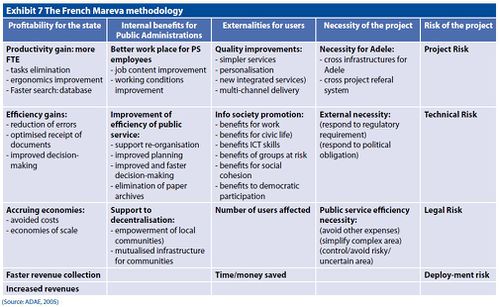MAREVA Methodology
MAREVA is a successful and innovative methodology to assess the value of public sector transformation projects. It helps administrations prioritize initiatives, manage them (evaluating alternatives, commit project leaders to concrete objectives), and build knowledge for further projects to optimize their value. MAREVA was launched in 2005 by the French eGovernment Agency (ADAE)and has been developed in parallel with implementing a new French law on public finances (the LOLF), which changes the state's budgetary processes and performance management. MAREVA contributes to serving the purpose of shifting public administrations towards result-based management of budgets, as it helps to provide a more-balanced assessment of costs and benefits, value, and risk as a way to better prioritize and manage project portfolios.[1] MAREVA is a successful and innovative methodology to assess the value of public sector transformation projects. It helps administrations prioritize initiatives, manage them (evaluating alternatives, commit project leaders to concrete objectives), and build knowledge for further projects to optimize their value. MAREVA was launched in 2005 by the French eGovernment Agency (ADAE)and has been developed in parallel with implementing a new French law on public finances (the LOLF), which changes the state's budgetary processes and performance management. MAREVA contributes to shifting public administrations towards result-based management of budgets, as it helps to provide a more-balanced assessment of costs and benefits, value, and risk to better prioritize and manage project portfolios.
Mareva methodology is a method for analysis of the impact of various government e-services. It is based on “return on investment (ROI) calculations for large public projects and comparable approaches in the private sector.” Since this approach is based on ROI, it focuses on four main aspects. The first one focuses on investment objectives and their alignment with the missions of the investor. Second, it monitors if the level of risk is acceptable for the project that is carried out. The method is focused on different types of risks: human, financial, technical, organizational, etc. The third aspect is related to a clear definition of project benefits and goals and their appropriate indicators showing the realization of progress. At last, Mareva focuses on expected benefits and their coverage of investment and costs. As such, Mareva is considered a predefined method and tool to assess the value of an e-government project. It has a more holistic approach focusing on project profitability and applying consistent evaluation of e-administration projects in which it considers both external and internal aspects. Monitored external aspects are based on benefits for individual users (i.e., citizens), organizations, and business entities. In contrast, internal aspects are based on elements of public sector employees and public administration. With ROI, the Mareva methodology is focusing on key elements for comparison of projects and risk control[2]

source: ADAE,2005-wibe-tco.com
See Also
